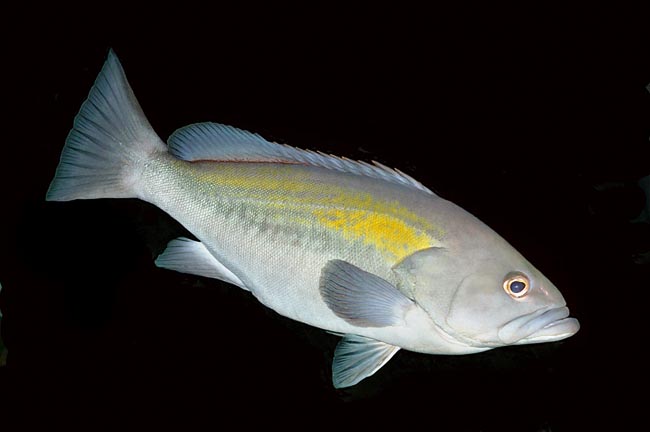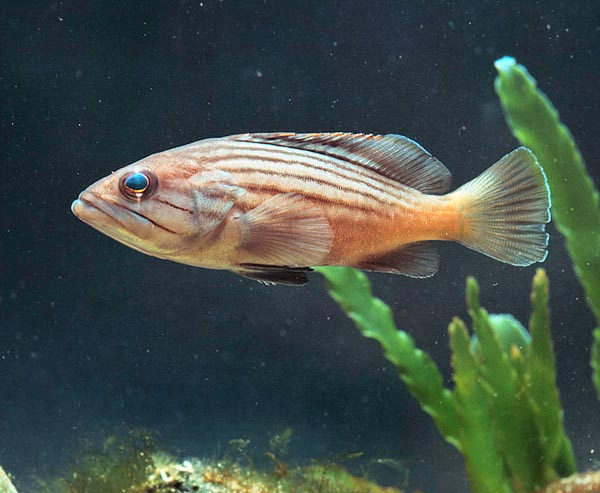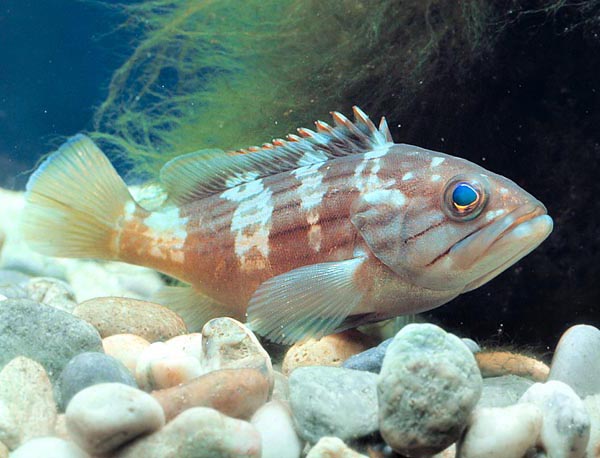Family : Serranidae

Text © Giuseppe Mazza

English translation by Mario Beltramini

Epinephelus costae adult male with the splendid dot spread on the sides © Giuseppe Mazza
The name of the genus comes from the Greek “epinefes” = cloudy, with probable reference to the mimetic and often changing patterns which characterize these fishes.
The name of the species, “costae” = of Costa, is a tribute to the memory of Oronzo Gabriele Costa (1787-1867) who, describing in 1844 a striped specimen in juvenile livery, erroneously called this fish Plectropoma fasciatus in his opus Fauna del Regno di Napoli (Naples Kingdom Fauna). Later on, they realized that, while growing, the stripes disappear, and the name is nowadays confined among the synonyms.
Zoogeography
The golden grouper is fairly common in the eastern Mediterranean, so much that it has also the synonym of Epinephelus alexandrinus (Valenciennes, 1828), but it has never been sighted in the Red Sea and in the Black Sea. In Italy, it is found around Sicily, in the lower Adriatic Sea and in the central Tyrrhenian Sea. Beyond the Gibraltar Strait, it has reached, by coasting Africa, Mauritania and Togo.

Young with the typical horizontal bands that had led to think to another species © Giuseppe Mazza
The Epinephelus costae loves the relatively warm waters and the rocky seabeds, but it can be found also in those mixed with sand.
Unlike the other groupers, usually solitary and sedentary, it moves in small schools between the 20 and the 80 m of depth. It swims calmly, for the whole day, at a certain distance from the bottom, looking for cephalopods, crustaceans, and fishes. Some say that it can go down up to 200 m while following some preys.
Morpho-physiology
The body, relatively tapered and compressed on the sides, may reach the 8 kg per a length of 80 cm, but there are reports of record specimens of 140 cm, obviously much heavier.
The head, with a triangular profile, has the lower jaw longer. The preoperculum is serrated at the bottom and operculum shows three robust spines bent towards the tail.
The teeth, quite numerous, of various shapes and disposed in rows, can hold and chew every sort of prey, and, for seizing the fugitives, at the apex of the mouth are evident two great hooked, caniniform, teeth. The dorsal fin has 11 spiny rays and 15-17 soft ones, the anal, shorter, has only 3 spines with 8 soft rays. The tail is ample, roundish in the juveniles, then flat and slightly concave in the adults. Spatulate pectoral and ventral fins are of similar size.
In the young individuals, the livery is of chocolate colour, with darker lines on the sides and two typical stripes, well marked, on the operculum.

The same specimen, scared, has a surprising mimetic livery © Giuseppe Mazza
In a few instants, depending on the mood, the may camouflage with spots and pale vertical bands, present, in a lesser degree, also in the adults.
Typical of the species is the yellow dot close to the operculum of the adults, extending on the sides in the males, close to a dark and irregular band which limits the lower part of the body, significantly clearer.
Ethology-Reproductive Biology
Recent studies, with samples taken in Algeria, have shown that the 19-35 cm long specimens nourish for about 2/3 of fishes, for almost 1/3 of crustaceans and, in small quantity, of molluscs: those between the 35 and the 50 cm, in equal parts of fishes and ascidians, whilst the menu of the old animals, with a size between the 50 and the 90 cm, is formed for a half of ascidians, ¼ of fishes and another ¼ of crustaceans, coelenterates and aquatic plants.
Little is known about the reproductive modalities of the golden grouper, apart the fact that it is a protogynous hermaphroditic species, that is, with females that while ageing, transform in males, and that the sexual maturity is reached when 30-35 cm long. The vulnerability index of this species is of 66 over 100.
Synonyms
Cerna catalonica Gilbert, 1913; Cerna chrysotaenia Döderlein, 1882; Epinephelus chrysotaenia Döderlein, 1882; Epinephelus zaslavskii Poll, 1949; Plectropoma fasciatus Costa, 1844; Serranus chrysotaenia Döderlein, 1882; Serranus costae Steindachner, 1878; Epinephelus alexandrinus Valenciennes, 1828.
→ For general information about FISH please click here.
→ For general information about BONY FISH please click here
→ For general information about CARTILAGINOUS FISH please click here.
→ To appreciate the BIODIVERSITY of BONY FISH please click here.
→ To appreciate the BIODIVERSITY of CARTILAGINOUS FISH please click here.
